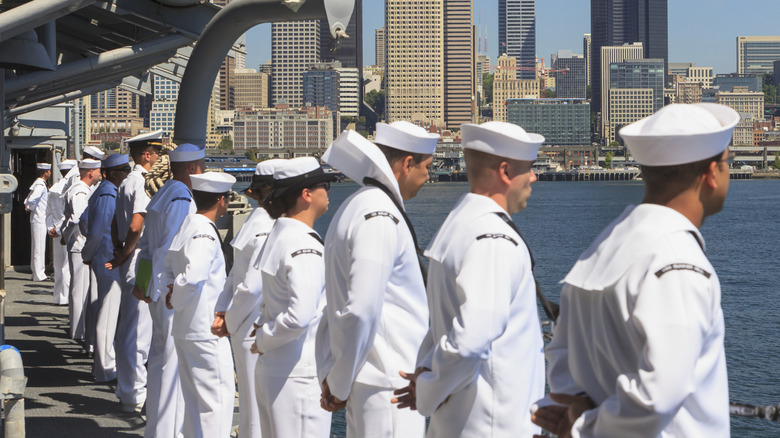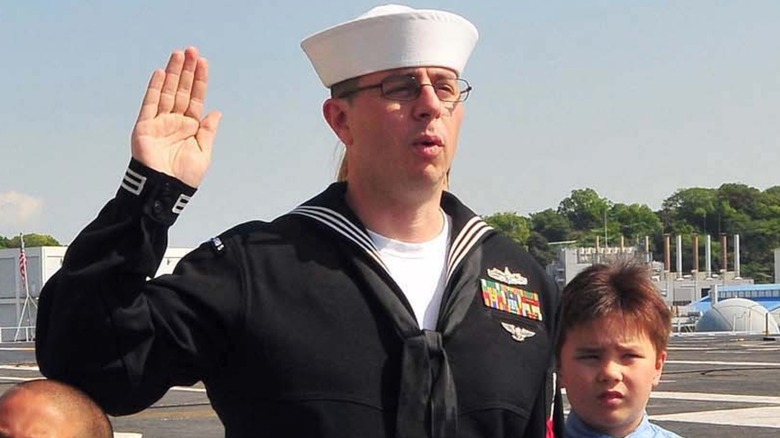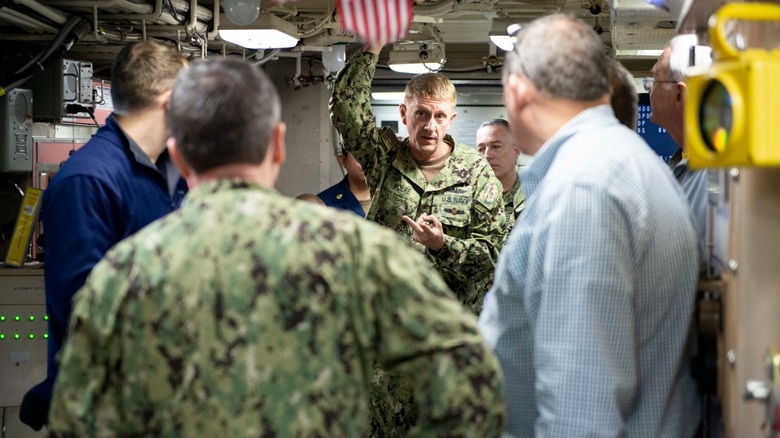Do US Navy Sailors Always Serve On The Same Ship?
The United States Navy is one of the oldest and proudest branches of the U.S. military. It's been around since 1775, though it was initially called the Continental Navy before it became the U.S. Navy in 1794. It's well known that the U.S. Navy is the most advanced and robust blue-water navy in the world, far outpacing every other nation in terms of advanced technology and overall strength.
The Navy doesn't have as many vessels as China, but it is the clear victor in terms of aircraft carriers, submarines, frigates, and destroyer strength. To make any of these ships and boats function, you need a crew, and that's where the bulk of the Navy's personnel come into play. Some ships, like the Zumwalt-class destroyers, have around 197 personnel, while the largest vessel and most advanced, the USS Gerald R. Ford (CVN-78), has a crew of 4,539 personnel. That's a lot of people, and sailors tend to spend a good chunk of their service on or under the water.
It's a fair question to ask if a sailor remains with the same vessel once they're assigned. It makes sense that they would, as they would be familiar with its systems and operations, but that's not how the U.S. military functions. Naval vessels have rotating crews that come and go periodically, transferring personnel between ships as standard operating procedure. In this way, the Navy is much like the other branches, which typically transfer personnel between bases every two to three years.
How personnel are assigned in the U.S. Navy
When someone enlists in the U.S. Navy and completes their training, they receive their first assignment. This is almost always on a ship, though it could be on the ground. It depends on two primary factors: the sailor's training and the needs of the Navy. There are other factors to consider, including the sailor's preferences, family situation, and more. Still, the Navy's needs are what drive assignments in the U.S. military.
For first-term enlisted personnel serving a standard four-year enlistment, they will not be given more than two assignments during that time. Ideally, a new sailor will cut their teeth while serving aboard a ship of some kind, but that doesn't always occur. There are different periods of time required for overseas assignments as well. Focusing solely on ships, which regularly leave and return to the continental United States, the Navy handles this type of assignment regularly.
A typical sailor might be assigned to a ship (known as sea duty), followed by a period of shore duty. Not all Navy personnel are on the water all the time, and there are plenty of jobs for the force to do on land. When their shore duty ends, they could return to their previous billet, but most often, they're assigned to a new vessel to aid in the sailor's individual rank and career progression. It's not uncommon to return to the same type of ship, but that's not always guaranteed.
What about the type of ship?
There are seven types of modern warships operated by the U.S. Navy, and each has different personnel requirements. There's one type of modern vessel that a sailor can only be assigned to if they volunteer. Submarines are very different vessels when compared to surface ships. They are compacted, they're constantly being hunted (or are doing the hunting), and they require people who are comfortable working in confined places. As a result, no sailor will receive a submariner position if they don't volunteer, but all other vessels are possible assignment locations.
Even submariners have difficulty staying on the same boat, but they are locked into the type of submarine on which they can serve. Flight deck crews on aircraft carriers are somewhat limited, but even they can be transferred to other vessels capable of launching aircraft, and they have shore duty with their squadrons. If a sailor serves aboard a ship and wants to return, they can request to do so, but it doesn't happen often.
Granted, this is rare, as the standard practice is rotation. Rotating crews keeps the force fresh, improves training across the board, and promotes career growth. Should the need arise, someone serving aboard an aircraft carrier who previously served aboard a frigate can return to that class of ship fairly easily. Ultimately, assignments are an ever-changing aspect of military service, so while a sailor isn't guaranteed to stay on the same vessel, it's a possibility and occasional occurrence.


